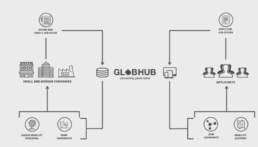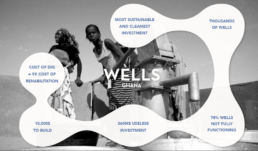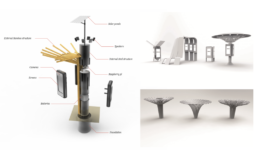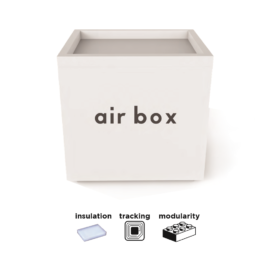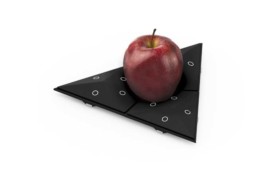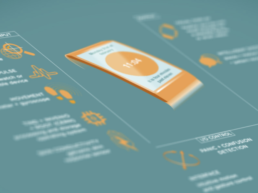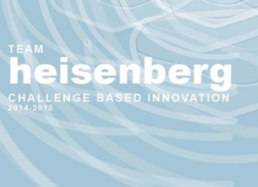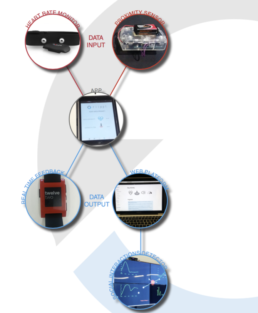Team Bohr – ElecTree
ElecTree is the first modular extendable plug-n-play intelligent grid solution designed to optimize electricity distribution in situations of scarce energy. It was conceived mainly for use at refugee camps, but its applications extend well beyond this realm.
The solution is built of different layers that extend from the electricity sources that are connected to the most important buildings at a camp, through a core grid. The grid then extends to the shelters, through hubs distributed throughout the camp. The hubs use Power Line Communication (PLC), to balance the energy demand with the supply, prioritize the
most important functions at a camp, and then distribute the excess energy to the shelters.
The project was the result of a three month process, framed under the Challenge based Innovation program: a multidisciplinary team of business, engineering and design students, collaborating with scientists in order to apply technology to tackle social issues. The team had access to various CERN resources, such as its technology portfolio and
facilities.
Moreover, the Design Thinking methodology was applied through out the process. Constantly listening to our stakeholders, understanding the needs of our final user, creating a customer journey, and many other resources, were crucial in order to assure that our solution would have a real impact on refugees.
Download the project documentation
Team Bohr - European Labour Mobility
How might we increase labour mobility within EU by supporting the workers with
useful and actionable information, drawn from big data?
Performed research has shown that there are 22.4M SMEs (50 to 250 employees) in UE willing to grow with the incorporation of international talent: hiring workers from abroad comes hand in hand with knowledge, new perspectives and creativity; and it supposes a wider pool of profiles to find the exact skills they require. At the same time, they need an efficient recruitment both in terms of time and budget, for cost of selection process is limiting for SMEs. And their investment must be protected: once they hire a candidate coming from abroad, there must be a guarantee that he/she will perform satisfactorily in the firm and will integrate into the new country, thus willing to stay in the firm instead of going back to the home country.
In parallel, there is a significant labour force looking for a job (242.3M seekers), and more than half of them (150M seekers) leverage on online platforms to spread their profile and increase their possibilities. In addition to finding a job, they pursue professional growth by means of an internationalization of their profile. This will eventually imply moving to a new country, so they will also need relevant information about accommodation, healthcare, bureaucracy and other practicalities, and most important: the reassurance and support of equals when moving abroad.
From the recruiters’ perspective, they can reach international talent and find best profile for their needs. We provide them with a ranking of candidates considering profile suitability and mobility potential, to make sure that workers coming from abroad will adapt to the country. Ranking is performed automatically, which shortens the process and improves recruitment efficiency.
From the candidate point of view, they can receive offers from all over Europe, which opens the door towards an international career and professional growth. Additionally, we provide them with relocation support, and we host a community of equals who can accompany them during mobility experience. In addition, for candidates who are not selected, we offer feedback on their mismatch for this selection process.
Finally, we collect feedback both from recruiters and candidates, which we use to improve internal operations for ranking the candidates.
Download the project documentation
Team Planck - Well2Go
How might we improve public health by providing safe access to water?
Our solution is focused on monitoring and maintaining water points in northern Ghana. The more we focused on the well maintenance problem, common themes kept coming up, which are crucial for the ability to keep wells working. Without them, long-term sustainability of maintenance is not possible. We discovered that all these elements must be tackled together, as a water monitoring ecosystem, to make sure there is water always.
Our Approach: The Water Monitoring Ecosystem
Maintenance will be carried out through the sensors and plumbers network just described. However, for the maintenance to be sustainable, the rest of the parts of the model are necessary.
Spare Parts Supply Chain - Knowing that spare parts shops are difficult to find in the northern region, we plan to have a pick-up point in Tamale, the capital of the Northern region, which will provide technicians with spare parts and tools needed for repair. We plan to use statistical optimization tools to set safety stock levels and minimize costs.
Long-Term Finance – there has been evidence in case studies that show that when communities are provided reliable water service, then their willingness to pay increases. This is where our community financing transition model will come in; it will make sure communities will pay for affordable maintenance in the long term, but will be transitioned into a payment and service model that is reliable in phases. It will also serve as a long term exit strategy for funding NGOs.
Community Engagement –we hope to engage the community by providing them with the information needed about the condition of nearby water sources, through the information point (placed with water group assigned wells), and through a mobile information request (voice).
Download the project documentation
Team Penrose - Creating a literate world
How might we significantly reduce child and youth illiteracy at scale in developing countries, with the use of technology?
Through our research and interviews, we discovered several aspects of both education/learning and the various contextual influences surrounding students themselves, specifically in Ghana. From this research we decided to reframe our challenge: how do we create an enriching learning experience? By designing our solution from this perspective, we hoped to create a service environment that would leverage several opportunities for integration into our target users’ lives.
In terms of an educational service, we provide tools for learning in the form of (1) learning games, (2) challenge based learning projects, and (3) access to Wikipedia. Learning games would teach rudimentary math and literacy skills in engaging/ gamified ways. For example, our prototype included a game where users learn how to write letters by tracing letters on a screen with their hands. A camera follows the motion of their movements and determines how close their tracing is to the true letter, thus assessing their competency. Challenge based learning projects would teach higher-level skills, as well as rudimentary literacy skills. Higher-level skills would include, but not be limited to, team building & teamwork, leadership, and analytical & problem solving skills. In addition to literacy, these higher-level skills would help users be even more suited for success (and more able to deal with difficulties) in future educational and professional endeavors. Content generation of games and projects would be an internal process, adding to our service’s competitive advantage. Lastly, Wikipedia would give users access to information should they seek out information in addition to what is provided through the games and challenges.
The community experience of our solution was also highly important to us in design of both the service and the physical form of the solution itself. Great care was taken in using aesthetics that would integrate into communities well, and therefore increase acceptance. However, just as critical if not more so, is our service design, which takes into account the busy lives of children in these Ghanaian communities. Analysis of our users’ daily journeys shows that great time and importance is given to duties such as fetching water, farming, working at the market, and other responsibilities that are usually critical to family survival. Users may also spend a great deal of time walking from location to location, so it was essential to make use of the sparse, yet valuable, free time that may be available to them. Through our contacts, we found that this free time was available generally in afternoons when children would access community playgrounds. Through this insight, we decided to place our knowledge kiosk, as well as design educational services, with this free time in mind.
Our service solution is therefore a piece of technology that integrates into student lives in addition to the education they receive in more traditional forms (i.e. school) without taking away from the necessities of day-to-day life. Our challenge based learning projects, additionally, have been designed from the perspective of engagement not only from the student standpoint, but also from the community standpoint. Through interviews we learned that older children/siblings have a highly influential role in the lives of younger children/siblings. This influence applies heavily to education, where older individuals motivate and/or take on teaching roles themselves. We leveraged this insight by designing group projects that would solve community issues as well as educate users. This would engage the community and older individuals to work with younger students to create, for example, a water filter. In addition, an “enabler” would be a part of the service to help guide, steer, and assess students during the process. The enabler is an employee of the service and would be sourced from the local community.
It is this combination of both non-traditional learning methodologies (gamification and challenge based learning) along with projects that leverage community relationships (community engagement and hierarchal teaching/motivation) that is the core of the Bamboo service. Furthermore, we sent sample portions of our curriculum to our contacts in Ghana for validation and testing. From their positive feedback, we saw not only the community engagement and acceptance that we hoped for, but also the availability and high interest of children to take part in our challenge based learning projects with the guidance of an enabler. We also sent a summary of our project to individuals in the Ghana Complementary Basic Education program, and they were very enthusiastic about our solution and how our curriculum could add much greater value than the current offering.
Download the project documentation
Team Kelvin - Food Safety
Challenge: How might we home deliver food in a new way that maintains the food cold, at a selected
temperature, ensuring its safety?
Our challenge is centred into delivering food supplies (perishable and non-perishable) in good conditions ensuring its safety. After analysing the current scenario doing interviews and benchmarking other company’ s activities we have redefined the problem considering both the role of retailers and the users. Home delivery is not profitable for retailers for many reasons: delivery business’ s margins are very low, logistics systems have a highly centralized structure which makes the whole system very rigid and always adds more steps to deliver the package at home, legislation puts a lot of restrictions on delivery and the service is perceived by the users as a costly advantage.
From the user’ s perspective, the service has several problems. First, many companies give a two-hour window to deliver and consumers have to wait at their place to receive the goods without to knowing the exact time. Second, many consumers are concerned about the quality of the food received. They feel the retailers give them low quality food.
In this way, we present a solution that makes the delivery process profitable for retailers without changing their supply chain, whereas we have relieved shoppers from the frustration of waiting at home for the shipment of their grocery. This result has been achieved by employing different insulating technologies. Indeed, we have developed a unique process which allows to combine silica aerogel (an insulating material) with paraffin-based phase-change materials (a heat absorber). This specific combination of materials is able to maintain constant the temperature of refrigerated/chilled foods, therefore preserving the safety and freshness of perishable items.
Besides insulating materials, our boxes are also equipped with sensors and RFID (radio-frequency identification) devices for providing information in real time for both retailers and shoppers. Retailers will receive information related to the delivery route and safety condition of the various food items, whereas shoppers will be continuously updated about the delivery time.
Download the project documentation
The Mat (Food Security)
Challenge: How can we contribute to food security by decreasing the loss and waste of food?
An adaptable platform designed to create a connection between people and food, using real-time sensing technology to remove any uncertainties regarding freshness and taste. We can’t make one product that covers each and every one of your needs, but we can create a protocol, a common language, which connects different products and services. Combined, it has an unlimited potential to change the world. We can pinpoint where waste is happening and which areas are over producing food, and consequently avoid billions of tons of waste.
Download the project documentation
INDE (Enhancing movement)
Challenge: How can we design a viable system, that allows people to restore or enhance their ability to move?
INDE: How to prevent hip fractures among elderly women? INDE is the concept of outcome from the second Challenge-Based Innovation (CBI) course organised in collaboration with CERN and multiple universities worldwide. The multi-disciplinary student team from Aalto University schools of Art & Design, Business and Engineering, ESADE Business School, IED and UPC Catalunya.
The team was given the assignment to enhance mobility. By looking to various forms of immobility, the team soon found out that a major issue in our society is the growing amount of problems related to old age. With this information, the team started looking into the significance of issues related to the falls and hip fractures caused by these falls among elderly people. The team also found out that 80% of hip fractures happen to the elderly women due to higher risk of osteoporosis and therefore the team found it reasonable to put emphasis on the women’s protective clothing.
The final working prototype presented at the CERN CBI gala by the team was a skirt attached with a reusable auto-inflator device and machine-learning algorithm to detect the fall patterns. With use of gyroscopes, accelerometers and charged carbon dioxide, auto inflation takes place before the person wearing the device hits the ground.
Download the project documentation
EMMA (Human sensory experience)
Challenge: How can we create a system for replicating human sensory experience over distance?
We all experience minor incidents of forgetfulness, but can you imagine the difficulties faced by those with mild cognitive impairment (MCI) or the early stages of Alzheimer’s disease… most can’t.Team Maxwell has developed EMMA; External Memory, Monitoring and Assist to improve the lives of sufferers.
By using advanced artificial intelligence to learn about the user, detect episodes of disorientation, confusion and panic and use this information to present appropriate information via an intuitive interface. EMMA is invaluable as an aid in maintaining independence and confidence in during the difficult early stages of Alzheimer’s or for anyone with MCI.
Download the project documentation
Blinx (3D sensing for the visually impaired)
Challenge: How can we provide a visually impaired person an improved way to experience the world and function satisfactorily in complex environments?
The world is built for people with sight and mostly the information of the environment is delivered visually. Learning your environment becomes very difficult if you cannot see properly. For the visually impaired, team Heisenberg created the ‘BLINX’. It’s an image processor worn on the wrist which gives a tactile stimulus through vibrations when the direction of the desired item is found. It is based on image processing technology and we vision it to scale up to finding objects from just giving reference points. We believe better information leads to better decisions and giving better life. Blinx is a step into that direction.
Download the project documentation
Sensing Interactions
Challenge: How can we design a wearable system that allows the wearers to access information about their effect on others around them by deepening the understanding of these interactions?
RIIPPL is a personal social skills training system. It is designed to assist people with social skills challenges such as Asperger’s Syndrome. These skill are essential for navigating the complexities of the world — for managing conflict, emotional resilience, developing fulfilling relationships and success at school and work. Just as fitness bands track physical exercise, RIIPPL will use wearables devices to collect data about how we interact with others. Using pattern recognition software, will identify social situations which make a user anxious and skills that are causing problems, like making conversational. It can suggest training exercises and challenges, track progress and provide real-time feedback and encouragement.
The goal is to empower users to develop the skills they need to confidently engage with others and realise their full potential.


